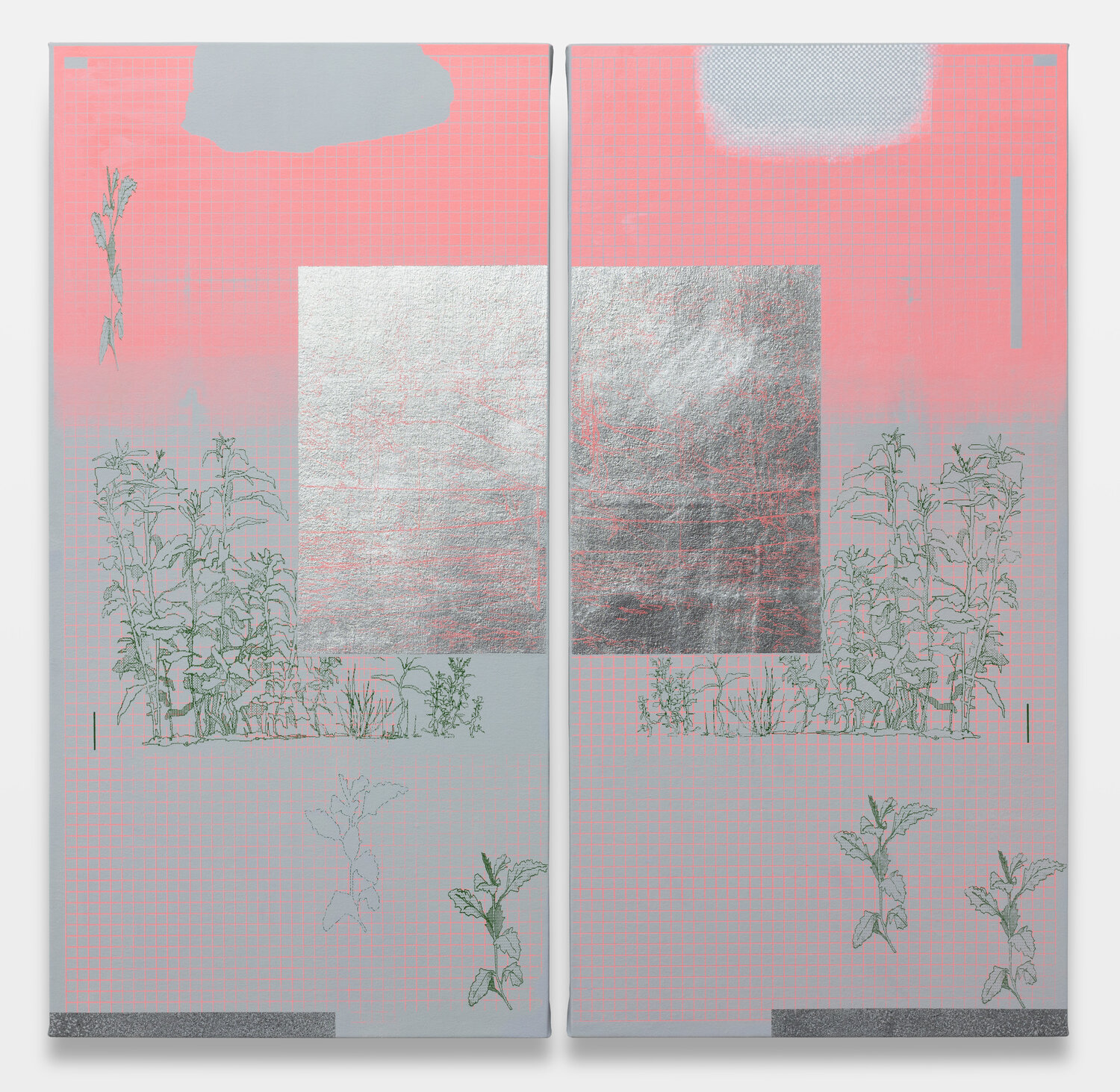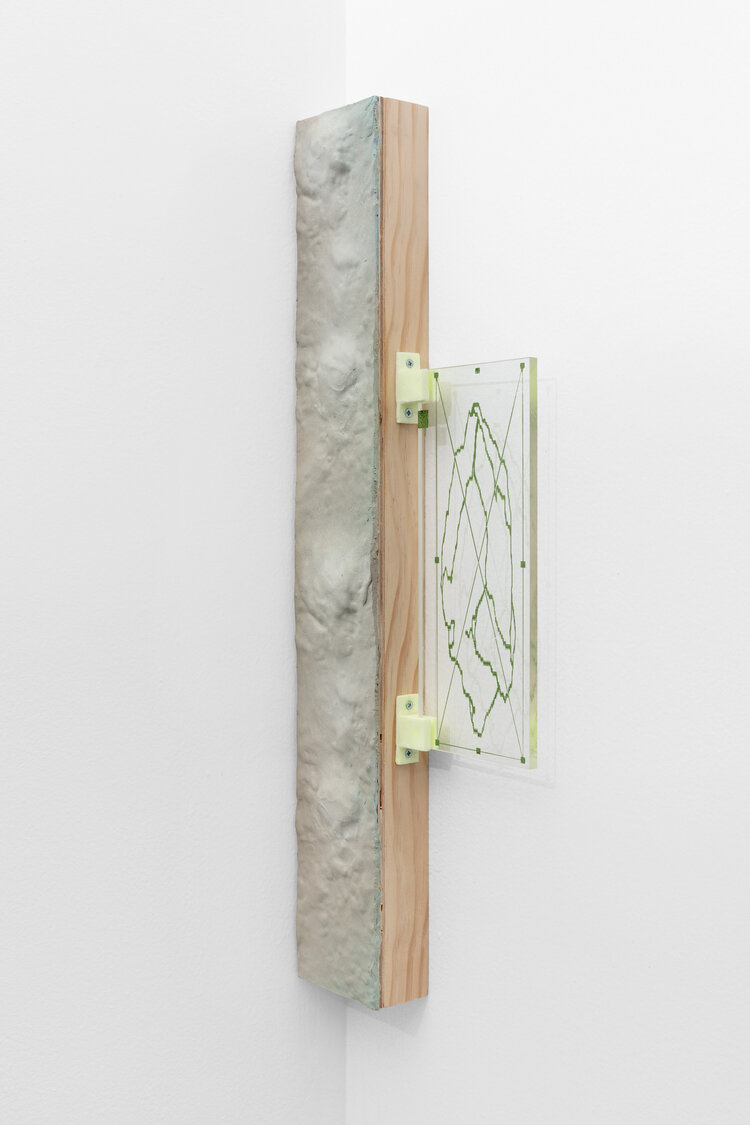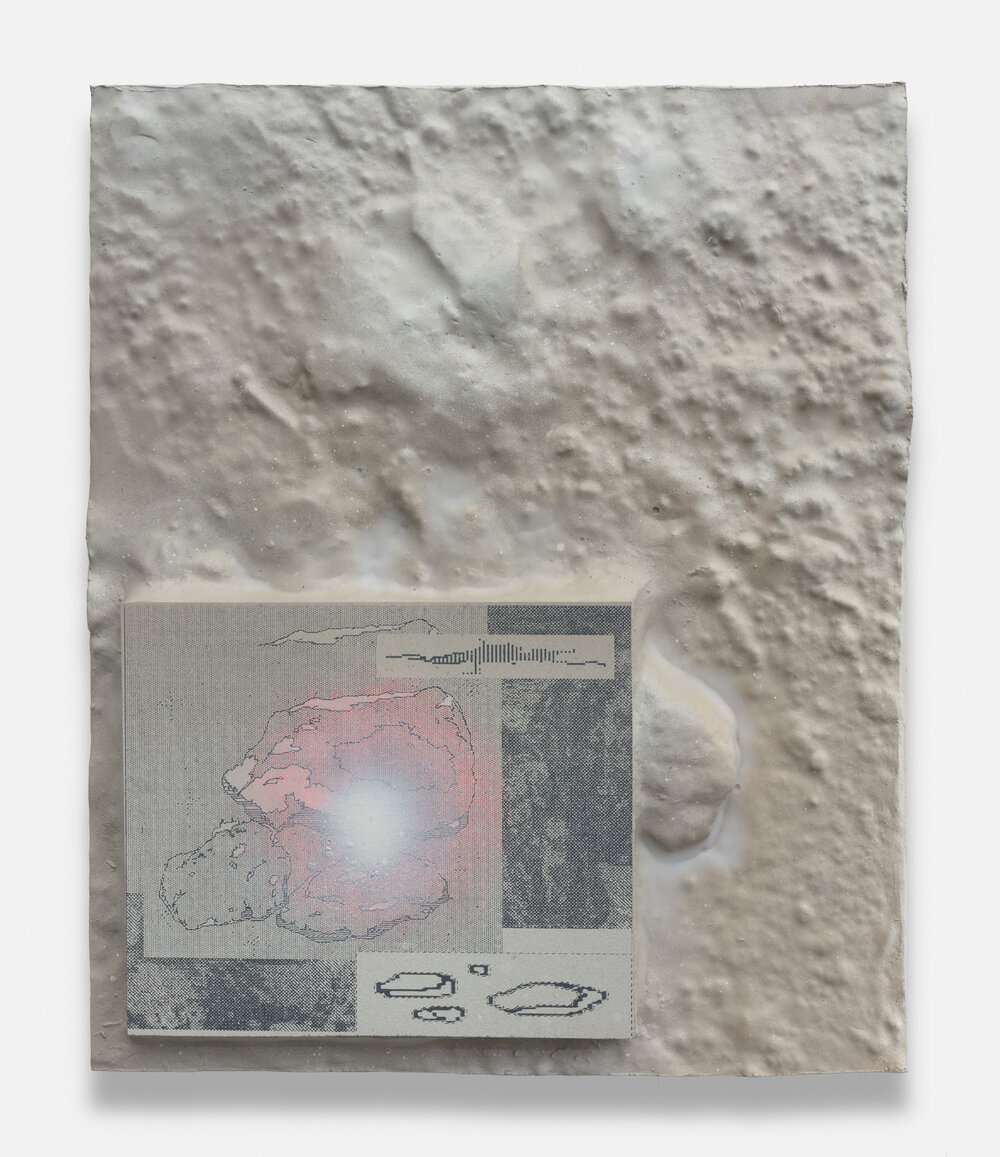Brooklyn-based Naomi Nakazato’s sculptural practice explores the complexities of landscape as interpreted through social, technological, and material concerns.
Nakazato examines the confluence of virtual and physical domains, drawing from the visual languages of sources such as Google Street View, Japanese shrines, and video games to explore the intersection of her Japanese and American heritage.
We spoke with Nakazato about Hito Steyerl and the horizon, intimacy, authenticity, and the visuality of translation.
![]()
Cloud Stairs I (first iteration) / 雲の階段 , 2020,
urethane, epoxy, acrylic, wood, screenprint on plexiglass, cyanotype, broadleaf plantain (Plantago major), giant foxtail (Setaria faberi),
30 x 42 x 60 inches
I like to start with a silly icebreaker, which you probably noticed, but do you have a Rose and Thorn for this week?
I think the Rose was honestly the cooler weather. It was so nice and misty this week. I’m ultra heat-sensitive and not looking forward to having to work in the summer season. I don't really have a thorn–I think I've been pretty grateful to be vaccinated and spend time with friends in a casual, uninhibited way. I was in a group show that opened on Saturday, so I enjoyed seeing everyone together during this transitory moment.
I saw that you had a show [Dodecagon, 2021] that opened on Saturday, and wanted to ask about the work in the show.
It features all of the members of Olympia, which is a gallery that is dedicated to “dismantling the cis-male art canon” through a focus on women, non-binary, and transgender artists.
It's a really great group of artists. There's also a range of where everyone currently stands in the trajectory of their career, so there's this really nice sort of diversity to the show, which is ultimately emblematic of everything that Olympia stands for.
It's a really great group of artists. There's also a range of where everyone currently stands in the trajectory of their career, so there's this really nice sort of diversity to the show, which is ultimately emblematic of everything that Olympia stands for.
I'm interested in the materials of the work that you have featured in that show, “Entropy 5evr.”
Even though I made that piece back in 2017, I'm not an artist that believes the idea that if a work is older than a year, then it’s spoiled milk. I enjoy showing older works, reintegrating them back into the mix and considering how my artistic practice has morphed over time.
I made that piece when I was in a residency in Leipzig, Germany, and at the time, it felt necessary to delve into objects and think about repurposing materials from what was available to me. The surrounding environment was very industrial with a lot of derelict factory buildings; it led me to consider an amalgam of materials, whereas I had previously only been painting on plexi and doing 2D work on traditional painting grounds.
I made that piece when I was in a residency in Leipzig, Germany, and at the time, it felt necessary to delve into objects and think about repurposing materials from what was available to me. The surrounding environment was very industrial with a lot of derelict factory buildings; it led me to consider an amalgam of materials, whereas I had previously only been painting on plexi and doing 2D work on traditional painting grounds.
![]()
Entropy 5evr, 2017
oil and acrylic on perspex, concrete, 5.25 x 6.25 x 3.75 inches
“I knew that I wanted to impart this feeling of veneration in loss, as I was working in an environment surrounded by all of these buildings that were falling apart. This basic train of thought led me to the concept of entropy and liquidation, specifically working with materials that lent themselves to this, either in their solidarity or in their defiance or both.”
Looking back at my objectives for this particular piece, I wanted a shrine for something that wouldn't necessarily have been memorialized. I knew that I wanted an object, to move away from the wall, and I knew that I wanted to impart this feeling of veneration in loss, as I was working in an environment surrounded by all of these buildings that were falling apart. This basic train of thought led me to the concept of entropy and liquidation, specifically working with materials that lent themselves to this, either in their solidarity or in their defiance or both. I felt this responsibility to try to use it all in such a way that was responsible for their inherent qualities.
To venerate entropy and its inevitability felt so backwards from anything I had approached conceptually and I didn’t know how to approach such a weighty concept, so I drove at internet and game humor a bit. The title is a flippant pull from the copypasta story that was widely circulated sometime around 2011, of a teen romance that ends with, ‘I ment to say I’ll luv u five-evr (dat mean he luv her moar dan 4vr)’; the fire is an image that was ripped from the Sims and then further broken down and pixelated.
To venerate entropy and its inevitability felt so backwards from anything I had approached conceptually and I didn’t know how to approach such a weighty concept, so I drove at internet and game humor a bit. The title is a flippant pull from the copypasta story that was widely circulated sometime around 2011, of a teen romance that ends with, ‘I ment to say I’ll luv u five-evr (dat mean he luv her moar dan 4vr)’; the fire is an image that was ripped from the Sims and then further broken down and pixelated.
![]()
Leipzig Relic, 2017
acrylic and colored pencil on acrylic sheet, found objects
approx. 14 x 17 x 7 inches

Leipzig Relic, 2017
acrylic and colored pencil on acrylic sheet, found objects
approx. 14 x 17 x 7 inches
Leading from that, I noticed the Instagram post you had with all the different video game landscapes. Do you have a game that you have either have loved forever or just a favorite one right now that you've been kind of looking at?
I grew up on PC and Gameboy games, and didn’t have access to a proper console, so I never really experienced dramatic, immersive landscapes or environments. I’m cherry picking what resonates with me on certain maps in regards to newness versus nostalgia.
With PC games, you’re often given a sort of framed control panel and a lot of the trappings of it remain on the surface; I'm vacillating between a sort of allegiance to easily accessible functions and predictability, and then craving the low grade anxiety of being thrown into unknown areas. I like the idea of this becoming enmeshed, but I also enjoy the control of an insular, sandbox mode of a game like Roller Coaster Tycoon, where the only disruption is when it rains and then all your visitors have to buy umbrellas. It all comes together with a kind of known or unknown causality.
The last game I played that had a major impact on the way I think about built worlds was Death Stranding; it’s so cinematic and gorgeous. And it really does consider the elements, weather, topography, and how the main character responds to these things, how you as a voyeuristic player respond to these things. I've been reading about Hideo Kojima and the cinematic narrative developed through cut scenes, which still feel relatively unknown and modern to me.
I think the first console game that I played that I considered as part of an understanding of my practice was Journey. Have you played that?
With PC games, you’re often given a sort of framed control panel and a lot of the trappings of it remain on the surface; I'm vacillating between a sort of allegiance to easily accessible functions and predictability, and then craving the low grade anxiety of being thrown into unknown areas. I like the idea of this becoming enmeshed, but I also enjoy the control of an insular, sandbox mode of a game like Roller Coaster Tycoon, where the only disruption is when it rains and then all your visitors have to buy umbrellas. It all comes together with a kind of known or unknown causality.
The last game I played that had a major impact on the way I think about built worlds was Death Stranding; it’s so cinematic and gorgeous. And it really does consider the elements, weather, topography, and how the main character responds to these things, how you as a voyeuristic player respond to these things. I've been reading about Hideo Kojima and the cinematic narrative developed through cut scenes, which still feel relatively unknown and modern to me.
I think the first console game that I played that I considered as part of an understanding of my practice was Journey. Have you played that?
![]()
Neither Here Nor There, 2019,
acrylic and vinyl on canvas, panel, 14 x 18 x 1.5 inches
The one with the little person that in a red jacket, sliding down little hills?
Yeah. (laughs) It's a short game. It's only about an hour and 15 minutes and it’s very linear and story-based. The objective isn't to do well, it’s more a focus on how you interact with your environment in a purely non-verbal way.
Before playing it for the first time, I had read a very basic review, which failed to mention that you occasionally get partnered with another live player. So during the first play, I thought this other identical character was an NPC [non-player character], and I went through the whole thing feeling really confused by the other players’ erratic choices and interactions. It felt wild when I pieced it together.
But there is this metaphor of guidance threaded through the whole game, this account of a history told by ancestors, and then you’re paired with another person who's probably played it before and is shepherding you through non-verbal cues. Also, the soundtrack is absolutely gorgeous. I could go on and on about it. But yeah, I would say any game that's really considering the players' involvement with the environment and landscapes is almost solely what drives my interest.
Before playing it for the first time, I had read a very basic review, which failed to mention that you occasionally get partnered with another live player. So during the first play, I thought this other identical character was an NPC [non-player character], and I went through the whole thing feeling really confused by the other players’ erratic choices and interactions. It felt wild when I pieced it together.
But there is this metaphor of guidance threaded through the whole game, this account of a history told by ancestors, and then you’re paired with another person who's probably played it before and is shepherding you through non-verbal cues. Also, the soundtrack is absolutely gorgeous. I could go on and on about it. But yeah, I would say any game that's really considering the players' involvement with the environment and landscapes is almost solely what drives my interest.
![]()
From Which Side of the Mouth Are These Various
Fires Put Out?, 2020,
silkscreen print on canvas mounted on panel,
vinyl, aluminium leaf, 50 x 48 x 1.5 inches
In terms of landscapes, I know, to some degree, your work involves identity. But I saw this Hito Steyerl quote on your Instagram – “It [verticality] is a proxy perspective that projects delusions of stability, safety, and extreme mastery into a backdrop of expanded 3-D sovereignty. But if the new views from above recreate societies as free-falling urban abysses and splintered terrains of occupation, surveilled aerially and policed biopolitically, they may also—as linear perspective did—carry the seeds of their own demise with them.”
I was wondering, within the concept of mapping, do you feel like you're still interacting with this intersection of politics or technology, and also how Google Maps kind of comes into that?
I was wondering, within the concept of mapping, do you feel like you're still interacting with this intersection of politics or technology, and also how Google Maps kind of comes into that?
In Wretched of the Screen (2012), Hito Steyerl specifically discusses perspective and how the screen is an extension or a resistance to these orientations. There’s an incredible bit about the horizon line and horizontality as something that's inherently like a Western idea as far as our understanding of space and spatial awareness. Lauren Berlant also goes into this quite a bit in Cruel Optimism (2011). Anyway, I was so blown away when I first read it, in her analysis and presentation of the politics of verticality.
One of the aspects of being biracial that I’m trying to represent is the framing and alignment of two spaces as one environment. Orientation has played a major role in this, and I’ve been studying East Asian landscapes specifically, where land and the objects within it are represented with an almost diametrically opposed syntax. It isn't so much like you have an object placed in the foreground, and then an expanse behind it that’s described with an atmospheric perspective, it’s more that you're reading it from top to bottom. So, distance-wise, objects that are higher up on the plane are further away, and things that are lower are closer.
One of the aspects of being biracial that I’m trying to represent is the framing and alignment of two spaces as one environment. Orientation has played a major role in this, and I’ve been studying East Asian landscapes specifically, where land and the objects within it are represented with an almost diametrically opposed syntax. It isn't so much like you have an object placed in the foreground, and then an expanse behind it that’s described with an atmospheric perspective, it’s more that you're reading it from top to bottom. So, distance-wise, objects that are higher up on the plane are further away, and things that are lower are closer.
![]()
Fifty Days or Forever, 2018,
acrylic and vinyl on unstretched canvas, urethane,
aluminum, 23.5 x 40.5 inches

Fifty Days or Forever, 2018,
acrylic and vinyl on unstretched canvas, urethane,
aluminum, 23.5 x 40.5 inches
“I'm still grappling with a lot of problematic elements in my understanding of the way I'm looking at land and geography, even back to this standardized idea of the horizon of the Western art canon. There is this idea of an aerial view being democratized, but for whom?“
Adding in this more contemporary idea of surveillance, specifically drone view, satellite view, or anything from an aerial view, it does, of course, feel sinister, and there is this idea of being a God as like a creator, which isn’t unlike being an artist.
I'm still grappling with a lot of problematic elements in my understanding of the way I'm looking at land and geography, even back to this standardized idea of the horizon of the Western art canon. There is this idea of an aerial view being democratized, but for whom?
Not to bring it back to games (laughs), but that is almost always the view you get when you're playing strategy and civilization games. You're always operating from a “god perspective,” which is so wild. The interactions aren’t environmental, it’s purely land grabs and resource-based decisions.
Relating this all to my practice, there is this sentimental, relational value I'm applying when I insert myself into virtual spaces, especially with [Google] Street View. The first-person perspective feels like a quiet, solo act in which I learn more about myself through the decisions I make, but it also does harken back to this history of the aggrandized spiritual epic of the western invader, so I'm aware of the thorny nature of the availability surveillance and these perspectives.
I'm still grappling with a lot of problematic elements in my understanding of the way I'm looking at land and geography, even back to this standardized idea of the horizon of the Western art canon. There is this idea of an aerial view being democratized, but for whom?
Not to bring it back to games (laughs), but that is almost always the view you get when you're playing strategy and civilization games. You're always operating from a “god perspective,” which is so wild. The interactions aren’t environmental, it’s purely land grabs and resource-based decisions.
Relating this all to my practice, there is this sentimental, relational value I'm applying when I insert myself into virtual spaces, especially with [Google] Street View. The first-person perspective feels like a quiet, solo act in which I learn more about myself through the decisions I make, but it also does harken back to this history of the aggrandized spiritual epic of the western invader, so I'm aware of the thorny nature of the availability surveillance and these perspectives.
![]()
Cyanotype No. 34_Summer 2020, 2020,
cyanotype on Strathmore bristol paper, 270 gsm, unique print,
7.5 x 11 inches
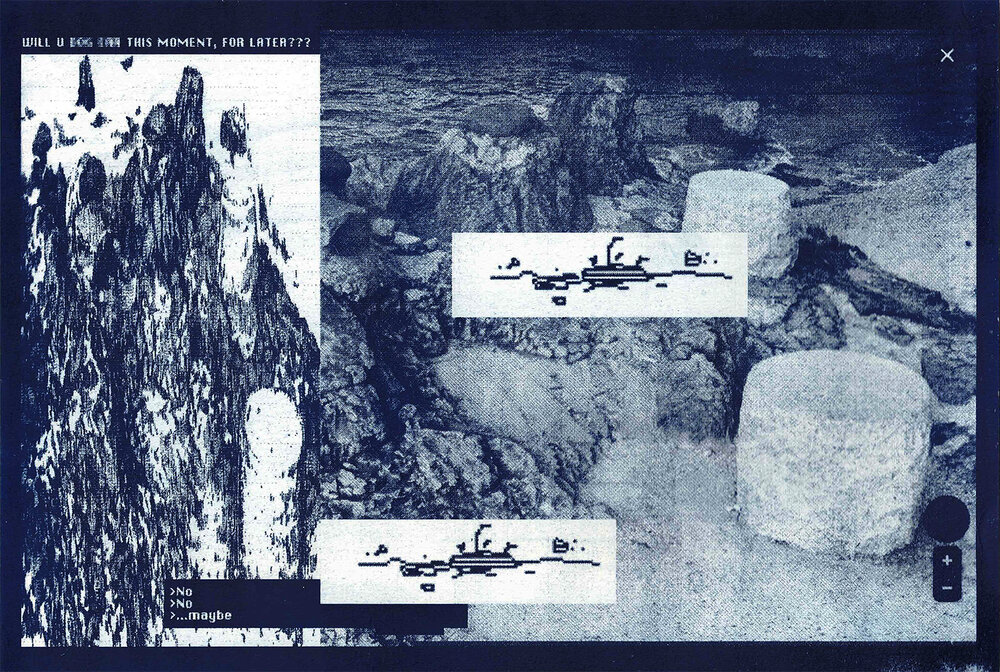
Cyanotype No. 34_Summer 2020, 2020,
cyanotype on Strathmore bristol paper, 270 gsm, unique print,
7.5 x 11 inches
You mentioned something about how in video games, you're like playing kind of a god figure on this expanse, which leads me to ask about how that mixes with your works that resemble shrines.
My formative experiences with shrines are solely derived from the time I’ve spent in Japan. On my first trip, there was a roadside shrine outside of a convenience store, next to a bus stop, that I felt distinctly affected by. After I went home, I spent a good amount of time trying to locate it on a map and of course, these smaller structures aren’t landmarked aerially. I think it might’ve been years later that I really started utilizing Street View seriously that I found it by walking around all the bus stops and convenience stores in this city.
I held onto the significance of this, and after my residency in Germany, I was already considering how the screen feels very much like a personal shrine, as some kind of channel for a reliquary or cache. When you're working in 2D formats, especially painting, you're sitting in front of a window and laboring in developing a space and inserting information. I wanted to bring that dedication and mentality to an object, I wanted the body to interact with it a bit more. Works that sit on the floor allow the viewer to activate and open that space for themselves, and the associations and ideas that are then brought to it aren’t so clearly defined by my initial ideas.
The front-facing interface and my use of upright plexiglass felt like the most direct, obvious choice in terms of design.
I held onto the significance of this, and after my residency in Germany, I was already considering how the screen feels very much like a personal shrine, as some kind of channel for a reliquary or cache. When you're working in 2D formats, especially painting, you're sitting in front of a window and laboring in developing a space and inserting information. I wanted to bring that dedication and mentality to an object, I wanted the body to interact with it a bit more. Works that sit on the floor allow the viewer to activate and open that space for themselves, and the associations and ideas that are then brought to it aren’t so clearly defined by my initial ideas.
The front-facing interface and my use of upright plexiglass felt like the most direct, obvious choice in terms of design.
![]()
A Soft Spot for a Rupture, 2020,
acrylic, polyurethane, screenprint on plexiglass thermoplastic
mounted on panel, 23.5 x 8 x 2 inches
In terms of the progression of your visual language, I saw that you did a lot of painting before and on your website, you don't really have any. I see the link there with the lithographs and prints, but I was wondering when you started to move away from pure figuration into something that’s more conceptual.
I graduated from a traditional grad program where you’re taught these venerated painting techniques, and it’s very figuration focused. My entire time there was spent in a resistance to it. I had applied with work that I had continued after my college art program, where I was trying to pull off a Kehinde Wiley approach to figuration, and appropriated images, where I was only scratching the surface of identity in an almost precious kind of way.
From the first semester, it felt like I was pigeon-holing myself into this conversation that I had started to move past. I didn't like this idea of using someone's image for my own artistic and personal gain, specifically because these were real people that I had begun to build community with. I wasn't abstracting them in any way, I was trying to get as veristic as I possibly could with technique and I began to feel repulsed by the whole approach. At this point, the environments in which these figures were built hadn’t really been considered, other than a seamless, non-space.
From the first semester, it felt like I was pigeon-holing myself into this conversation that I had started to move past. I didn't like this idea of using someone's image for my own artistic and personal gain, specifically because these were real people that I had begun to build community with. I wasn't abstracting them in any way, I was trying to get as veristic as I possibly could with technique and I began to feel repulsed by the whole approach. At this point, the environments in which these figures were built hadn’t really been considered, other than a seamless, non-space.
![]()
HenoHenoMoHeji, 2018,
silkscreen print on kitakata, edition of 2, 20.5 x 17 inches
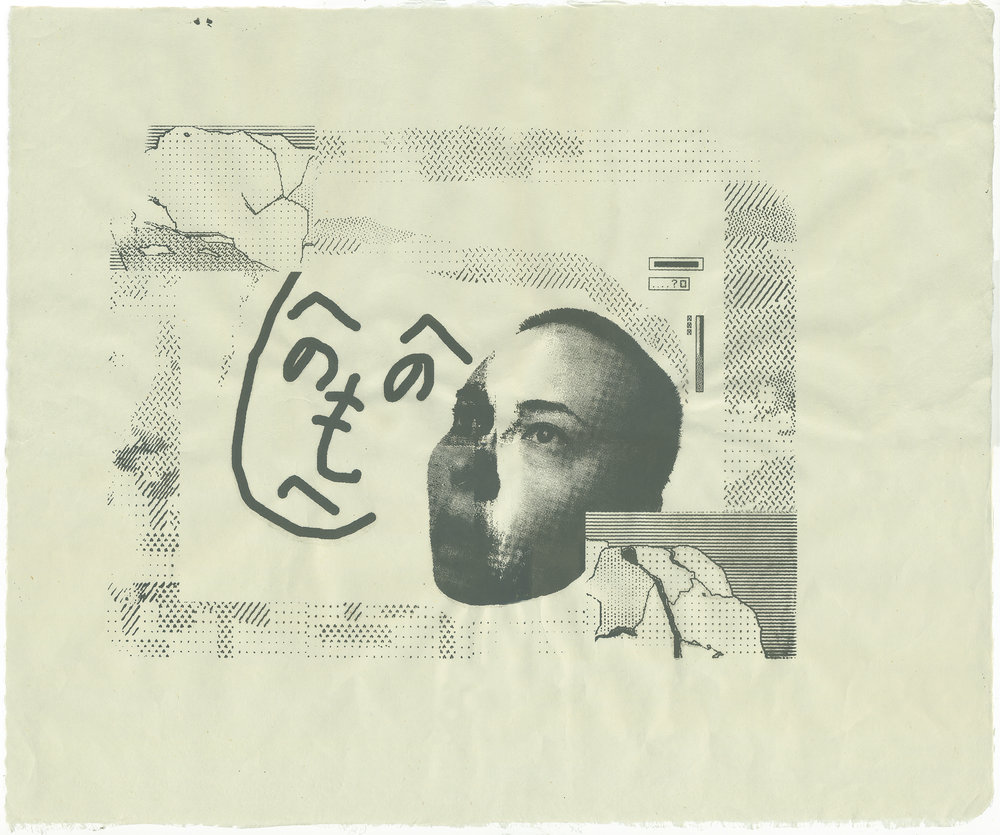
HenoHenoMoHeji, 2018,
silkscreen print on kitakata, edition of 2, 20.5 x 17 inches
“I was looking for boundaries, specifically in regards to what I could access. I was asking questions like how far can this Google Map maps car go, what’s at the end of this street?”
During the summer, the school offered me the residency in Germany, and that's when I really started considering landscapes and the non-figurative ideas that led me to the work I’m doing now. I spent a good deal of time walking around the factory that housed the residency, and then juxtaposing that time with geographical research via virtual walks in remote areas in Japan. I was looking for boundaries, specifically in regards to what I could access. I was asking questions like how far can this Google Map maps car go, what’s at the end of this street?
This all naturally led to the question of what the boundaries of in-between spaces? How are they being manifested visually, and are they boundaries that should be defined and understood? Or can they shift mercurially and still be ruptured?
This all naturally led to the question of what the boundaries of in-between spaces? How are they being manifested visually, and are they boundaries that should be defined and understood? Or can they shift mercurially and still be ruptured?
![]()
Swollen Feet, 2018,
urethane, lithograph mounted on MDF, acrylic on panel,
20 x 24 x 20 inches
It's also speaking to material, but the question I have is about this recurring theme of rock formations, and whether that relates more so to Shinto shrines or landscape, in general? Or it being the intersection of the natural landscape, and this larger concept?
I've been working with the semantics of natural formations and objects for a few years now. I originally started using rocks as glib stand-ins for blockades or non-computable language; like when you’re typing, and there's a text box that comes up, either because there's no character for it or you haven't updated your software yet.
And then this flippant syntax of objects morphed into something a bit more serious, during a moment when I was starting to juxtapose it all with this really grandiose idea of the landscape from a Western perspective. I had been looking specifically at the Hudson River school and too much Caspar David Friedrich. From there, it was about balancing this visually inflated representation of landmass with an East Asian aesthetic approach and general philosophical emphasis on the fragment and its continued value as an object in it’s removed state.
My development of this language has been a trajectory of describing the singular fragment, to the whole, to something not quite one or the other. It's also just a self-directed challenge–how much can I represent this icon over and over and over again? What is the longevity of one's own iconography before it collapses from exhaustion?
And then this flippant syntax of objects morphed into something a bit more serious, during a moment when I was starting to juxtapose it all with this really grandiose idea of the landscape from a Western perspective. I had been looking specifically at the Hudson River school and too much Caspar David Friedrich. From there, it was about balancing this visually inflated representation of landmass with an East Asian aesthetic approach and general philosophical emphasis on the fragment and its continued value as an object in it’s removed state.
My development of this language has been a trajectory of describing the singular fragment, to the whole, to something not quite one or the other. It's also just a self-directed challenge–how much can I represent this icon over and over and over again? What is the longevity of one's own iconography before it collapses from exhaustion?
![]()
Google Translation No. 2, 2018,
urethane, acetate, acrylic on panel 24 x 36 x 36 inches
“Both in a visual and theoretical sense, any negative space holds incredible weight where everything needs to be placed carefully and intentionally. With the transparency layer, it serves as a sort of transitory and hidden place to develop, and then later supplant and present whatever was sitting on the surface.”
In the same way I’m utilizing these visual cues of nature as a definition of space and language, I'm also trying to use various materials and studio processes as a place of becoming.
An example would be something like, and I can really reach and get metaphorical with Photoshop features and tasks, the transparency layer that sits below all of your other layers. That grid checkered pattern, to me, represents a kind of charged non-space for potential. Both in a visual and theoretical sense, any negative space holds incredible weight where everything needs to be placed carefully and intentionally. With the transparency layer, it serves as a sort of transitory and hidden place to develop, and then later supplant and present whatever was sitting on the surface.
An example would be something like, and I can really reach and get metaphorical with Photoshop features and tasks, the transparency layer that sits below all of your other layers. That grid checkered pattern, to me, represents a kind of charged non-space for potential. Both in a visual and theoretical sense, any negative space holds incredible weight where everything needs to be placed carefully and intentionally. With the transparency layer, it serves as a sort of transitory and hidden place to develop, and then later supplant and present whatever was sitting on the surface.
![]()
Omikuji, 2018,
urethane, plexiglass, aluminum, acrylic on canvas on panel,
5 x 6.5 x 6 inches
I noticed in one of your rock altar works [Omikuji, 2018] there's the checkered pattern, and I didn't make the connection to PNGs in Photoshop. That one is striking, because it has this plexiglass box with an exit button.
That's the other thing I’ll sometimes do–the rocks, in addition to being visual roadblocks, also represent examples of one-to-one attempts to interact and communicate in Japanese, again in a humorous but also heartbreaking kind of way. Any instances in which I’ve been unable to articulate verbally or pronounce words have felt weighed down by this film of the anxiety of being inept and wanting to exit easily (laughs).
In terms of imagery, where do the tree stumps relate to what you said earlier about these boundaries in terms of entropy and cycles?
They’re used in a similar manner as rocks, building a visual language to describe boundaries. The ones with clean cuts are maybe more evidence of the desire to control an environment or desire for absolutism.
Both rocks and stumps also feel like such easy clip art and an intro emblem of nature; I’ll also say that while they serve as blockades, in their developed states of collection and arrangement they’re also entry points, much like written characters in languages.
Both rocks and stumps also feel like such easy clip art and an intro emblem of nature; I’ll also say that while they serve as blockades, in their developed states of collection and arrangement they’re also entry points, much like written characters in languages.
![]()
Scorched Earth (Flesh n Blood), 2017,
colored pencil, acrylic, cyanotype on panel, 29 x 20 x 1.75 inches

Scorched Earth (Flesh n Blood), 2017,
colored pencil, acrylic, cyanotype on panel, 29 x 20 x 1.75 inches
The cyanotype prints that you've been doing are really interesting because you're making these cyanotypes that look digital, which ties into this idea of melding nature and technology based renderings of the world. How do you make them and how do you conceptually view them?
I’m gushing because they’re so much fun. I'm always recommending them to anyone who expresses any interest, because it's such a casual printmaking process and there’s something so satisfying in the speed of it.
I really don't want to use the term blueprint, it’s too on the nose, but cyanotypes are my way of materializing layouts and drawings for more process-intensive works. It feels like an important part of my preliminary work to have a physicality to the digital rendering. There is a bit of labor involved, you’re treating this paper with a one-to-one, part a, part b chemistry and then exposing it, but it feels like more prep than anything else. Just before I leave the house, I'll print out a stack of transparencies, and if it's sunny out, I'll run out with one.
The whole cyanotype process already feels contingent to nature and the environment because I do them seasonally–in a New York winter, it’s virtually impossible and I refuse to use a UV exposure unit. It's honestly nice to just stand outside with like, half a cig and wait for your image to expose.
I really don't want to use the term blueprint, it’s too on the nose, but cyanotypes are my way of materializing layouts and drawings for more process-intensive works. It feels like an important part of my preliminary work to have a physicality to the digital rendering. There is a bit of labor involved, you’re treating this paper with a one-to-one, part a, part b chemistry and then exposing it, but it feels like more prep than anything else. Just before I leave the house, I'll print out a stack of transparencies, and if it's sunny out, I'll run out with one.
The whole cyanotype process already feels contingent to nature and the environment because I do them seasonally–in a New York winter, it’s virtually impossible and I refuse to use a UV exposure unit. It's honestly nice to just stand outside with like, half a cig and wait for your image to expose.
![]()
Some Open Tab, 2018,
cyanotype 8.5 x 11 inches
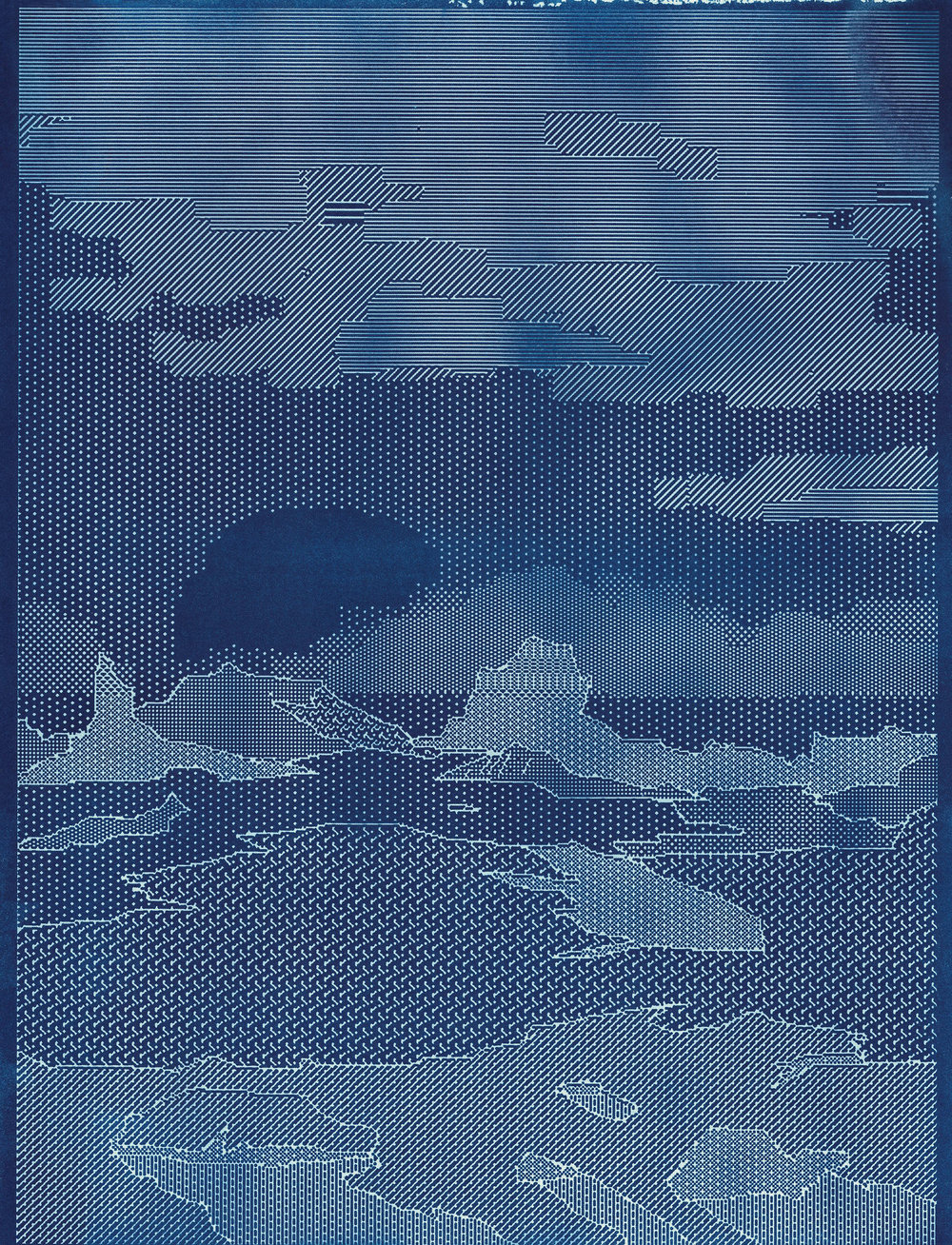
Some Open Tab, 2018,
cyanotype 8.5 x 11 inches
“...cyanotypes are my way of materializing layouts and drawings for more process-intensive works. It feels like an important part of my preliminary work to have a physicality to the digital rendering.”
Cyanotypes can only really develop properly when it's incredibly bright outside, and part of it is looking for the perfect place to expose your image. With overcast or cloudy days, you might get something more underexposed or enigmatic, but with the way that I'm working from the process, I want them to be crispy.
In a similar, outdoor process kind of way, I’ve recently started using this thermoplastic material, which I've been using to mimic the natural forms found on this small island in Japan. Ever since I visited it, I've been trying to sort of see if I can find spots around the studio or just anywhere in the city that maybe resemble that same topography. But in that attempt to mine a space or recreate a space effect, I end up creating an entirely new landscape from it.
In a similar, outdoor process kind of way, I’ve recently started using this thermoplastic material, which I've been using to mimic the natural forms found on this small island in Japan. Ever since I visited it, I've been trying to sort of see if I can find spots around the studio or just anywhere in the city that maybe resemble that same topography. But in that attempt to mine a space or recreate a space effect, I end up creating an entirely new landscape from it.
![]()
Gut Fare, 2020,
acrylic, screenprint on thermoplastic mounted on panel,
12.875 x 10.75 x 1.625 inches

Gut Fare, 2020,
acrylic, screenprint on thermoplastic mounted on panel,
12.875 x 10.75 x 1.625 inches
The thermoplastic was my next question, in terms of material. You have these wall works that have the squares of printed images, and around it, you have space that feels very topographical.
For those particular pieces, I was just starting out with this process. I didn't want to invest in a heat gun, which is the typical way of getting it to a pliant state, but you can use boiling water to mold this material to surfaces. Whatever is under it will serve as a sort of matrix in its transformation.
I realized only a few months ago that all of my favorite processes are ones that involve some sort of transformative quality via water, or there is some sort of revealing through water.
I realized only a few months ago that all of my favorite processes are ones that involve some sort of transformative quality via water, or there is some sort of revealing through water.
There's a video of you playing with water on the plastic on your Instagram. Does water feel like a new material or concept that you're working with given that you've worked with plants and rocks? Especially with some of the more recent works it looks like there's this white, gluey, liquidy feeling to it.
This is so topical––yesterday I made a GIF of a water drop, and I realized I don't really ever describe water. I'll render tide pools in my landscapes, but my linear approach of drawing them is more descriptive of the area they encompass, like fencing in non-space. They don’t hold anything. So, in this way, water is a linchpin in process, where it's formative, but visually it's not being described. It's a space that doesn't exist in this world that I've pieced together, but it's the driving force behind everything.
Sorry, not to go back to videogames incessantly, but historically in the videogame industry, water has always been one of the most difficult things to render and I’ve always been latently obsessed. It always looks really piece-y or like another liquid, like mercury. Among developers, it was this pursuit of who can render water the most realistically, and I’m just not interested in trying to describe it at all.
Sorry, not to go back to videogames incessantly, but historically in the videogame industry, water has always been one of the most difficult things to render and I’ve always been latently obsessed. It always looks really piece-y or like another liquid, like mercury. Among developers, it was this pursuit of who can render water the most realistically, and I’m just not interested in trying to describe it at all.
![]()
Lint, 2020,
acrylic, screenprint on thermoplastic mounted on panel,
12.875 x 10.75 x 1.625 inches
To go back to the idea of water, was that something of a breakthrough or a way to continue your practice?
Honestly, I haven’t figured it all out yet. I enjoy this as a more unseen, indulgent part of my studio processes, and I’m less interested in the theoretical implications in its visual representations.
In terms of authenticity and intimacy, do you feel like that impulse is a natural way of pushing back against our increasingly digital world. We're being kind of put into these facsimiles and there’s this push towards authenticity and intimacy. Is that a tension that you're exploring in relation to the images you're using?
The casting of natural materials came as an easy response to the objective of producing objects and the satisfaction of authenticity as a secret. I started casting natural objects sometime in my last semester of grad school and I was immediately attracted to this idea that the object’s origins were unknown unless you felt the weight of it or interacted with it in a very close way.
I think one of the things that I really cherish as an artist is the secrecy of certain practices in the studio, or aspects about a work’s origin that you can choose to articulate, like we're doing right now in this interview. And because of that, there is a sort of agency over the way you present these objects, but also a deeper unspoken attachment to what you’ve produced.
But to answer your question, the weight of authenticity comes from origin and expectation. For me, the overwhelming desire of authentically presenting and passing is fluency, all in one effortless go. I’m beginning to tug at this desire in a vulnerable, open way in transparency with materials in their intrinsic states, with ruptured images, with the reproduction of inept bits over and over, in leaving something as opposed to forcing it all on a level playing field, so to speak.
So, the question maybe now is, how do I seek out the indulgence of aforementioned concealed processes, while allowing the miscarriages of presenting as valid and belonging?
I think one of the things that I really cherish as an artist is the secrecy of certain practices in the studio, or aspects about a work’s origin that you can choose to articulate, like we're doing right now in this interview. And because of that, there is a sort of agency over the way you present these objects, but also a deeper unspoken attachment to what you’ve produced.
But to answer your question, the weight of authenticity comes from origin and expectation. For me, the overwhelming desire of authentically presenting and passing is fluency, all in one effortless go. I’m beginning to tug at this desire in a vulnerable, open way in transparency with materials in their intrinsic states, with ruptured images, with the reproduction of inept bits over and over, in leaving something as opposed to forcing it all on a level playing field, so to speak.
So, the question maybe now is, how do I seek out the indulgence of aforementioned concealed processes, while allowing the miscarriages of presenting as valid and belonging?
![]()
Salt-ii, 2019,
fiberglass, aluminium leaf, plexiglass, wood, acrylic on canvas mounted
on panel, 30 x 30 x 50 inches

Salt-ii, 2019,
fiberglass, aluminium leaf, plexiglass, wood, acrylic on canvas mounted
on panel, 30 x 30 x 50 inches
You have these little text bubbles that utilize what seems like video game language. What role does language play in your practice?
Because I’m essentially illiterate with Japanese, I'm always using an intermediary translating interface. In the same way that I've been relying on Google Maps, I've also been relying on Google Translate, and I've been especially fascinated with the image to text mechanics of the app. It’s not perfect, and there is this curiosity to feed random text through to see what makes it through.
I don't know if y'all have ever used this function of Translate, but you just scan anything with text and all of these little translated bits pop up and are projected onto it. I’m so thoroughly entertained by it, to the point that I made a zine / artist book of Google Translate-d fortunes that you can find at Buddhist shrines and temples. When using the app, the more you move it around, the more it'll come up with these alternative translations. The way that I was altering it, you could essentially, like, pick which version of your future seems more pleasant in its wording?
Anyways, I’ve continued using the translations of these fortunes, inserting bits of my own existential questioning, to then flatten it all out and masquerade it as something that resembles game dialogue.
I don't know if y'all have ever used this function of Translate, but you just scan anything with text and all of these little translated bits pop up and are projected onto it. I’m so thoroughly entertained by it, to the point that I made a zine / artist book of Google Translate-d fortunes that you can find at Buddhist shrines and temples. When using the app, the more you move it around, the more it'll come up with these alternative translations. The way that I was altering it, you could essentially, like, pick which version of your future seems more pleasant in its wording?
Anyways, I’ve continued using the translations of these fortunes, inserting bits of my own existential questioning, to then flatten it all out and masquerade it as something that resembles game dialogue.
![]()
Study for Magic Wand Weed Garden No. 1, 2020,
acrylic on watercolor paper, 12 x 9.5 inches
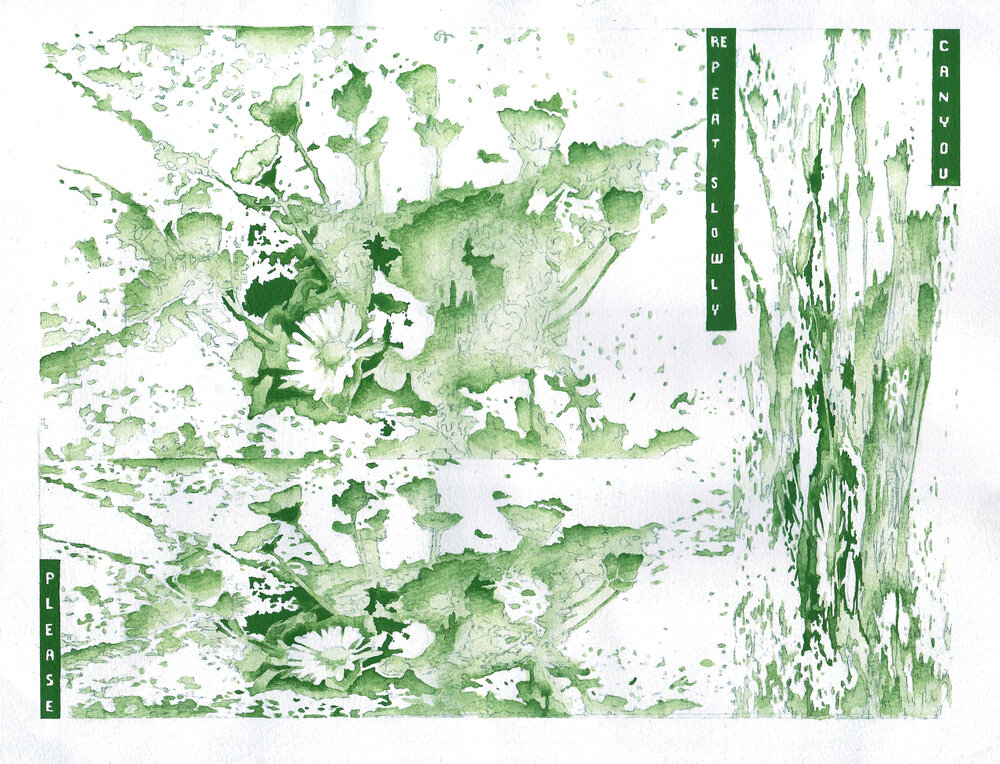
Study for Magic Wand Weed Garden No. 1, 2020,
acrylic on watercolor paper, 12 x 9.5 inches
Visit Naomi Nakazato’s artist page.
︎: @naominakazato




